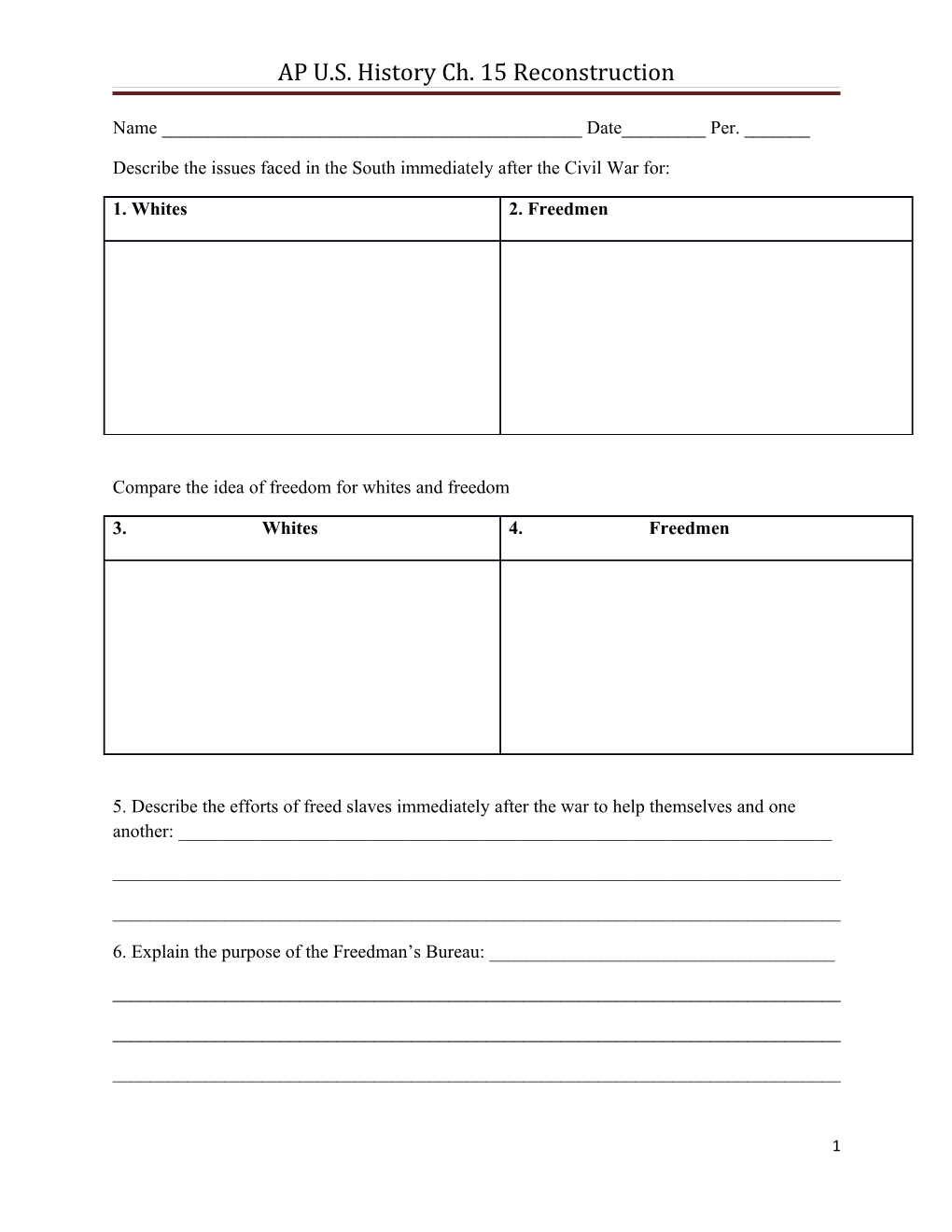AP U.S. History Ch. 15 Reconstruction
Name ______Date______Per. ______
Describe the issues faced in the South immediately after the Civil War for:
1. Whites / 2. FreedmenCompare the idea of freedom for whites and freedom
3. Whites / 4. Freedmen5. Describe the efforts of freed slaves immediately after the war to help themselves and one another: ______
______
______
6. Explain the purpose of the Freedman’s Bureau: ______
______
______
______
Describe the following plans for Reconstruction of the South. Be specific!
PLAN / DETAILS / RRESULT7. Lincoln’s 10% Plan
8. Wade-Davis Bill
9. Johnson’s Restoration Plan
10. Briefly describe Andrew Johnson’s point of view regarding racism and post-war Southern aristocrats. How did it change? ______
______
______
11. What were the ‘Black Codes’? How did Congress respond to them? ______
______
______
______
12. What was the 14th Amendment? Explain the controversy surrounding its passage.______
______
______
13. Explain the necessity and purpose of passage of the 15th Amendment______
______
______
14. Define the Tenure of Office Act and its purpose:______
______
______
15. Define the Command of the Army Act and its purpose:______
______
______
16. What was Ex parte Milligan? Explain its importance.______
______
17. Describe the impeachment of Andrew Johnson and its ultimate result______
______
______
18. Who were known as scalawags?______
19. Who were known as carpetbaggers?______
20. In what ways did newly enfranchised African Americans work together to maintain political power in the South after Reconstruction? What role did churches play? ______
______
______
______
21. Describe the efforts to expand education in the South:______
______
______
22. What did the Civil Rights Act of 1875 hope to accomplish? Was it successful?______
______
______
______
23. Explain the concept ‘forty acres and a mule’______
______
______
24. Describe the system of sharecropping and the crop-lien system. What was its economic effect on blacks and on whites? ______
______
______
______
25. Explain the system of credit developed by local country stores in the South:______
______
______
26. Describe the Election of 1868 and its results______
______
______
______
Identify and describe the following scandals in the Grant Administration:
27. Credit Mobilier28. Whiskey Ring
29. What led to the Panic of 1873? What were the issues and how was it resolved?______
______
______
______
______
30. Briefly describe ‘Seward’s Folly’______
______
______
31. What were the ‘Alabama claims’ and how were they linked to the Treaty of Washington?
______
______
______
32. -35 Trace the issues that led to the abandonment of Reconstruction
a.
b.
c.
d.
36. List the various ‘secret societies’ that emerged in the South. Who were they, what was their purpose and their tactics? ______
______
______
37. What were the Enforcement Acts? What effect did they have? ______
______
______
______
38. What was ‘Social Darwinism?’ What role did it play in the North? ______
______
______
39. Describe the details and impact of the Compromise of 1877 on Reconstruction.______
______
______
40. Who were the ‘Redeemers’ or ‘Bourbons’? Describe their political agenda.______
______
______
41. What was the ‘Readjuster challenge? ______
______
42. What was meant by the term the ‘Industrial South? ______
______
______
43. What impact did railroads have upon the South?______
______
______
44. Describe the factory system in the South. Which group frequently provided the labor? _____
______
______
45. Explain the convict-lease system ______
______
______
46. What was the ‘New South creed?’ ______
______
______
47. Identify Booker T. Washington and his message regarding education.______
______
______
Describe the following cases
48. Plessy v. Ferguson. / 49. Cummings v. County Board of Education50. Describe the various ways whites endeavored to disenfranchise blacks including the concept of ‘Jim Crow laws’______
______
______
______
51. Describe the phenomenon of lynching the in South. Who was Ida B. Wells and what was she able to accomplish? ______
______
______
______
To what extent did the reforms survive the Compromise of 1877?
52. Political53. Social
54. Economic
Analyze the economic consequences of the Civil War on the following in the United States between 1865 and 1880.
55. Agriculture56.Labor
57. Transportation
58. Industrialization
What were the political achievements and failures of the Grant Administration?
59.Achievements60. Failures
1
